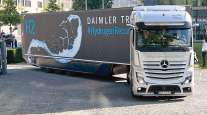DTNA’s Daum Sees Boom, But Wants to Know When
This story appears in the Aug. 9 print edition of Transport Topics.
Fourteen months into his job as CEO of Daimler Trucks North America, Martin Daum said the truck sales market is still bad — although it is improving — but his real challenge is trying to figure out when sales will return to a robust pace.
Daum said during a July 28 conference call with Transport Topics editors and reporters that he is highly confident fleets will return to buying trucks in strong numbers, but he doesn’t know when.
Predicting the timing for recovery “is the most difficult thing,” Daum said. “Even a prediction for 2010 is difficult.” At the Portland, Ore., original equipment manufacturer, his managers look at Classes 6-8 vehicle sales in Canada, Mexico and the United States as their market, he said.
“Earlier, 220,000 units was our prediction for 2010, but now it’s probably closer to 200,000. We don’t see the third- and fourth-quarter upswing that we once did,” he said, “but on 2011, we see a lot of positive indicators.”
The actual volume for 2009 was 187,000.
Some of the indicators he stressed were high average fleet age, improving freight volumes, and strong used truck sales and truck rentals. The combination of those factors usually means fleets will turn soon to buying new trucks, he said.
The record year for North American truck sales was 2006, “and all of those 2006s are now four years old,” he said.
Used truck inventories at Daimler’s SelecTrucks unit have dropped substantially, relative to a year ago, and pricing for the better vehicles is at a good level, Daum said.
DTNA is selling 30% more spare parts than six months ago, he also said, as fleet operators are trying to fix up their vehicles after delaying maintenance during
the recession. Some customers’ maintenance costs, he said, have become “extremely high” — another sign that truck buying will soon make sense.
He also said truck tonnage is on the rise from last year (8-2, p. 1; click here for previous story).
When Daum succeeded Chris Patterson, who retired last year, DTNA had made its last Sterling brand truck three months earlier. Daum said his staff has worked to convert Sterling buyers to Freightliner customers and estimated that he has been successful with retaining 80% of Sterling’s customers.
The company is still selling Sterlings that remain on dealer lots, in about the same numbers as Western Star Trucks, also a Daimler brand. The Western Star niche is usually for the most power-intensive severe-service applications, such as oil-field services and logging.
Daimler has kept the Western Star brand despite the small number sold, and Daum said he wants to increase its volume by offering more vocational trucks.
The three Daimler brands combined made up 33.9% of U.S. heavy-duty truck sales in the first half of this year. During the first six months of 2009, the market share was 32.4%, according to WardsAuto.com.
Daum said the market-share improvement returns Daimler closer to its “natural place.”
“Daimler brands once had about a 40% share of the NAFTA market. . . . We want to be above 35% — especially in the longhaul segment. I’m not a person who likes second place; 35% is a must,” he said.
Besides converting Sterling customers, Daum said, DTNA has been trying to advance vocational sales, particularly in Class 7 and the lower level of Class 8, sometimes called “Baby Eights.”
Having slogged through 2009, Daimler can endure low volumes for one or two years, Daum pointed out, but then it needs to see some improvement.
To grab whatever sales he can, Daum said that, while Daimler Trucks slashed its global spending on many items to survive the severe recession, the company kept its engineers busy on research and development for trucks and engines.
He described a process of continuing improvements, sometimes in small degrees, that also must be cost-effective.
“The trucks in 2015 will be far better than those of today, but the improvement won’t come in one leap,” he said. Daimler engineers are focusing on lower carbon dioxide output, and the best way to do that, he said, is to improve mileage.
Many fuel-efficiency gains, he said, are in the neighborhood of 3% or less, and when they are of such a small magnitude it often can be difficult for a fleet to actually experience them. Perhaps the biggest change could derive from increased adoption of better automated transmissions. That change could produce 10% more fuel efficiency, depending upon the driver’s skill, he said.
Daum said that six years is often the dividing line on whether an improvement will meet with commercial success.
“If the payback is approaching six years, it’s difficult for sales guys, but if it’s longer than six years, fleets just won’t buy it,” he said.




